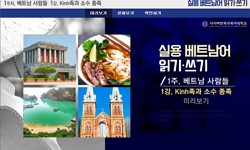Mekong delta is the largest delta in Vietnam with an area of 39000㎢, or 12% of the country’s. Therefore, the delta, together with Hochiminh City, has been and will be playing a very crucial role in Vietnam’s cultural-economic development strateg...
http://chineseinput.net/에서 pinyin(병음)방식으로 중국어를 변환할 수 있습니다.
변환된 중국어를 복사하여 사용하시면 됩니다.
- 中文 을 입력하시려면 zhongwen을 입력하시고 space를누르시면됩니다.
- 北京 을 입력하시려면 beijing을 입력하시고 space를 누르시면 됩니다.

토속종교가 베트남 사람들의 생활문화에 끼친 영향 = CÁC TÔN GIÁO BẢN ĐỊA VÀ ẢNH HƯỞNG CỦA NÓ ĐẾN DỜI SỐNG VĂN HÓA CỦA NGƯỜI VIỆT NAM BỘ
한글로보기https://www.riss.kr/link?id=A76521928
-
저자
Ngo Van Le (베트남 국립 호찌민 인문사회과학대학교)
- 발행기관
- 학술지명
- 권호사항
-
발행연도
2009
-
작성언어
Undetermined
- 주제어
-
KDC
330
-
등재정보
KCI등재
-
자료형태
학술저널
-
수록면
65-111(47쪽)
- 제공처
- 소장기관
-
0
상세조회 -
0
다운로드
부가정보
다국어 초록 (Multilingual Abstract)
Mekong delta is the largest delta in Vietnam with an area of 39000㎢, or 12% of the country’s. Therefore, the delta, together with Hochiminh City, has been and will be playing a very crucial role in Vietnam’s cultural-economic development strategies. Yet, while Mekong delta is a fairly new land in comparison with our nation’s long history, it has been a “promise land” or a “land of hope” to many migrants who have migrated to and resided over the delta in their pursuing of wealth and happiness. Many generations of the Vietnamese, side by side with other ethnic peoples, have exploited and protected the region which resulted in several magical achievements during wars against foreign invaders as well as in peace time.
Mekong Delta is resided by multi-ethnic peoples. These peoples, who are different in terms of economic development level, social structure and religion, have come to existence over the land at different time points. However, through long history of co-residence, due to cultural exchange and acculturation, among the peoples there have emerged many common cultural features and this process is currently still on progress under proactive influences of modern circumstance. As a result, there have been many religions in the delta; besides world religions such as Buddhism, Christianity, and Islam, there have existed local religions. Obviously, these religions contribute greatly to the cultural diversity of the whole southern part of the country.
The Vietnamese is a majority people in the region. The culture of the Vietnamese in Mekong delta has selectively inherited cultural values of Vietnamese tradition. During their residing in the delta, the people has also adopted and created cultural features that are adaptative to natural and social environment of the region. For instance, at the end of 19^(th) century and early 20^(th) century, the Vietnamese in Mekong delta created several religions with ubiquitous local identities. In general, local religions have played very crucial roles in the life of the Vietnamese in the delta; however, their impacts have seldom spread out of the Vietnamese communities.
In this paper, by viewing religion as both a social phenomenon and a cultural one, I concentrate on proposing the reasons for the birth of local religions of the Vietnamese in Southern Vietnam at the end of 19^(th) and early 20^(th) century. Also, I want to take a look at these religions’ impacts over cultural life of the people in the region. Assumedly, they were born under specific conditions of the South and only have impacts upon the life of the people. Furthermore, the paper proposes that, on one hand, the Vietnamese in the South have selectively inherited traditional cultural values which have created Vietnamese cultural values as the whole; on the other hand, they have made their own ones within the context of their new living conditions.
목차 (Table of Contents)
- Ⅰ. Những nét chung đồng bằng sông Cửu Long
- Ⅱ. Nguyên nhân làm nảy sinh những tôn giáo bản địa ở đồng bằng sông Cửu Long
- 1. Tính chất phản động của triều đình nhà Nguyễn
- 2. Đời sống khổ cực của những người lao động
- 3. Sự phản kháng của nhân dân:
- Ⅰ. Những nét chung đồng bằng sông Cửu Long
- Ⅱ. Nguyên nhân làm nảy sinh những tôn giáo bản địa ở đồng bằng sông Cửu Long
- 1. Tính chất phản động của triều đình nhà Nguyễn
- 2. Đời sống khổ cực của những người lao động
- 3. Sự phản kháng của nhân dân:
- 4. Cuộc xâm lược của Pháp và những hậu quả của nó
- 5. Thành phần cư dân phức tạp
- 6. Không có hệ tư tưởng chủ đạo chi phối
- 7. Một môi trường sống đa dạng
- Ⅲ. Đậc trưng đáng lưu ý về tôn giáo bản địa ở Nam Bộ Việt Nam
- Ⅳ. Ảnh hưởng tôn giáo bản địa đến đời sống của cu dân Nam Bộ Việt Nam
- Ⅴ. Kệt Luận
동일학술지(권/호) 다른 논문
-
- 조선대학교 국제문화연구원
- Dinh Thi Khang
- 2009
- KCI등재
-
- 조선대학교 국제문화연구원
- Joseph J. Hobbs
- 2009
- KCI등재
-
- 조선대학교 국제문화연구원
- Le Thi Quy
- 2009
- KCI등재
-
- 조선대학교 국제문화연구원
- Nguyen Duc Dan
- 2009
- KCI등재




 RISS
RISS 스콜라
스콜라



